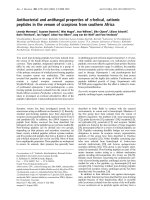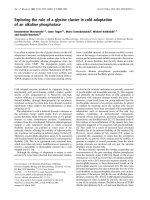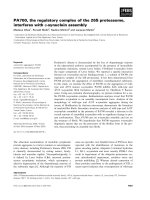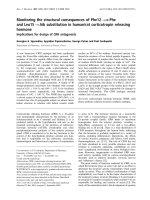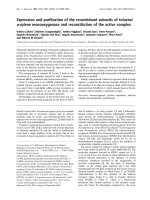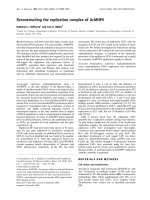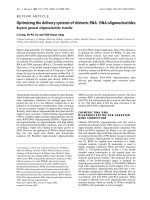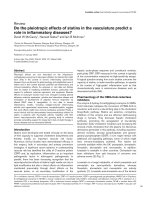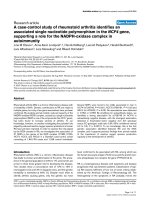Báo cáo Y học: Reconstructing the replication complex of AcMNPV pdf
Bạn đang xem bản rút gọn của tài liệu. Xem và tải ngay bản đầy đủ của tài liệu tại đây (192.31 KB, 8 trang )
Reconstructing the replication complex of AcMNPV
Kathleen L. Hefferon
1
and Lois K. Miller
2
1
Center for Virology, Department of Botany, University of Toronto, Ontario, Canada;
2
Department of Entomology, University of
Georgia, Athens, GA, USA
Baculoviruses are well known for their large, circular, dou-
ble-stranded DNA genomes. The type member, AcMNPV,
is the best characterized and undergoes a succession of early,
late and very late gene expression during its infection cycle.
The viral genes involved in DNA replication have previously
been identified and their products are required for the acti-
vation of late gene expression. In this study, we FLAG- and
HA-tagged the replication late expression factors of
AcMNPV, examined their expression and functional
activities by CAT assay and Western blot analysis, and
determined their subcellular localization in transfected
cells by subcellular fractionation and immunofluorescent
microscopy. We found that all replication LEFs with the
exception of P143 and P35 resided in the nucleus of trans-
fected cells. We further investigated the interactions among
various replication LEFs using both yeast two-hybrid and
coprecipitation strategies. A summary of the interactive
properties of the replication LEFs is presented and a model
for a putative AcMNPV replication complex is offered.
Keywords: Autographica californica nucleopolyhedrosis
virus; coprecipitation; DNA replication; late expression
factor; yeast two-hybrid system.
Autographa californica nucleopolyhedrosis virus, or
AcMNPV, is the type member of the Baculoviridae, a
family of double-stranded DNA viruses with large circular
genomes. The successive and concomitant expression of an
assortment of early, late and very late genes are instrumental
for successful baculovirus infection, and require a switch
from early dependence on a host cell-derived RNA poly-
merase II to a novel virus-encoded RNA polymerase that is
required for transcription later on in infection. A series of
repetitive and highly conserved sequences known as
homologous regions, or hrs, may function both as origins
of DNA replication as well as transcriptional enhancers of
late gene expression. An array of AcMNPV genes expressed
early on during infection, known as late expression factors,
or LEFs, are essential for both replication and late gene
expression [1–4].
Eighteen LEFs had previously been shown to be neces-
sary for late gene expression in Spodoptera frugiperda
(Sf-21) cells; more recently, an additional factor, known as
LEF-12, has been identified and was found to be essential
for transcription [5–7]. Nine late expression factors are
involved in viral replication. Of these, HEL and DNAPOL
contain sequence motifs characteristic of helicases and
DNA polymerases, respectively [8–10]. IE1 has been
demonstrated to play a role in both the initiation of
replication as well as transactivation of late gene expression
[11,12]. In addition to playing a role in transactivation, IE2
is involved in cell cycle control [13]. P35, an inhibitor of
apoptosis, circumvents the cell defence pathway to prevent
programmed cell death [14]. LEFs 1, 2 and 3 have been
suggested to carry out primase and single-stranded DNA
binding protein (SSB) activities, respectively [15–17]. No
role has yet been attributed to LEF-7, which like P35 and
IE2 has also been demonstrated to be essential in AcMNPV
replication in Sf-21 cells, but not Trichoplusia ni (Tn-368)
cells [18,19].
Little is known about how the replication LEFs
assemble into a replication complex during viral infection.
To gain further insight into the nature of the baculovirus
replication complex, the interactions between each of the
replication LEFs were investigated more thoroughly.
Constructs were generated which express amino-terminal
HA- and FLAG-tagged versions of each LEF. The
subcellular localization of each tagged LEF was deter-
mined by immunofluorescence using anti-HA and anti-
FLAG Igs. The relative strengths of interactions between
replication LEFs were examined using the yeast two-
hybrid system and the results were confirmed by copreci-
pitation studies. A working model of AcMNPV replication
complex assembly is presented.
MATERIALS AND METHODS
Cell culture and transfections
Spodoptera frugiperda (fall armyworm) IPLB-SF-21 cells
and Trichoplusia ni (cabbage looper) Tn-368 cells were
maintained in TC-100 medium (Gibco-BRL Laboratories,
Gaitherburg, MD, USA) supplemented with 10% (w/v)
fetal bovine serum and 0.26% (w/v) tryptose broth.
Transfections were carried out as described previously
[20].
Correspondence to K. L. Hefferon, Cornell Research Foundation,
Cornell University, 20 Thornwood Drive, Ithaca, NY 14850, USA.
Fax: +1 607 257 1015, Tel.: +1 607 257 1081,
E-mail:
Abbreviations:AcMNPV,Autographa californica nucleopolyhedrosis
virus; CAT, chloramphenicol acetyltransferase; hrs, homologous
region; hsp70, heat shock protein 70; LEF, late expression factor;
ONPG, o-nitrophenyl-b-
D
-galactopyranoside; SSB, single-stranded
DNA binding protein.
(Received 14 June 2002, revised 26 September 2002,
accepted 1 November 2002)
Eur. J. Biochem. 269, 6233–6240 (2002) Ó FEBS 2002 doi:10.1046/j.1432-1033.2002.03342.x
Expression plasmid construction
To construct the epi-tagged expression plasmids, primers
encompassing open reading frames of lef-1, lef-2, lef-3, lef-7,
P35, ie-1, ie-2, DNApol and P143 were HA-tagged at the
amino terminus by insertion of PCR products into the BglII
and PspAI sites of plasmid phsp70HAHisVI+ containing
the 5¢ terminal amino acid sequence RYPYDVPDYARA.
The sequence YPYDVPDYA constitutes the haemaggluti-
nin epitope (HA.11) [7].From these DNA manipulations, the
plasmids phsp70HAHISLEF-1VI+, phsp70HAHISLEF-
2VI+, phsp70HAHISLEF-3VI+, phsp70HAHISLEF-
7VI+, phsp70HAHISP35VI+, phsp70HAHISHELVI+,
phsp70HAHISDNApolVI+, phsp70HAHISIE1VI+ and
phsp70HAHISIE2VI+ were constructed using primers
listed in Table 1. In these constructs, hsp70 refers to the
Drosophila melanogaster heat shock protein 70 (hsp70)
promoter, HA refers to the HA.11 epitope and HIS refers
to the His
6
tag that is fused to the N-terminus of the lef open
reading frame inserted into the vector. VI+ refers to
sequences containing the AcMNPV polyhedrin open
reading frame, located within the vector. FLAG-tagged
expression plasmid counterparts were constructed with
the same primers by insertion of PCR products into
phsp70FLAGHISVI+ containing the 5¢ terminal sequence
RDYKDDDDKLENSRA. The sequence DYKDDDDK
constitutes the FLAG epitope. Reporter plasmid pCAPCAT
contains the CAT (chloramphenicol acetyltransferase) gene
under the transcriptional control of the late vp39 promoter
as well as a 473 nucleotide MluI fragment containing a
portion of the origin of replication hr5. Two-hybrid yeast
constructs were generated by PCR of each lef and insertion
into the EcoRI and XhoI sites of plasmids PJB4-5 and
PEG202, respectively, using primers listed in Table 1. The
sequence of all plasmids constructed using PCR products
were confirmed by direct nucleotide sequencing.
Transfections and CAT assays
Sf-21 and Tn-368 cells were transfected using lipofectin
reagent (Gibco BRL). 1 · 10
6
cells were transfected with
2 lg of the reporter plasmid pCAPCAT, and either 0.5 lg
of each of the clones of the overlapping AcMNPV k library
or 1.0 lg of each plasmid of the overlapping lef library as
described by Passarelli and Miller (1993; [15]), unless
otherwise noted. Transfected cells were incubated at 28 °C
Table 1. Primers used for the creation of replication LEF constructs.
Primer HA/FLAG constructs Two-hybrid yeast constructs
LEF-1 5¢ CATCACGATCTATGTTAGT GGCCCGGGAATTCATGTTAG
GTGCAATTATAC TGTGCAATTATAC
LEF-1 3¢ CCGCCCGGGTTATGTGGTAC GGCCCGGGAGCTCTTATGTG
TTTTTG GTACTTTTTG
LEF-2 5¢ CATCACAGATCTATGGCGA GGCCCGGGAGCTCTATGGC
ATGCATCG GAATGCATCG
LEF-2 3¢ CCGCCCGGGAATTACAAAT GGCCCGGGCTCGAGTTACAA
AGGATTG ATAGGATTG
LEF-3 5¢ CATCACAGATCTATGGCGAC GGCCCGGGAATTCATGGCG
CAAAAGATC ACCAAAAGATC
LEF-3 3¢ CCGCCCGGGTTACAAAAATT GGCCCGGGCTCGAGAATTTA
TATATTC TATTC
LEF-7 5¢ CATCACAGATCTATGTCGAG GGCCCGGGCTCGAGATGTC
CGTTACAAAGCG GAGCGTTACAAAGCG
LEF-7 3¢ CCGCCCGGGTTATTCTTTCA GGCCCGGGCTCGAGTTCTTT
CAATTCTG CACAATTCTG
HEL 5¢ CATCACAGATCTATGATTGA GGCCCGGGGAATTCATGATT
CAACATTTTAC GACAACATTTTA
HEL 3¢ CCGCCCGGGTTAACATACA GGCCCGGGCTCGAGCATAC
AAATTTGGTACAC AAAATTTGGTACAC
DNApol 5¢ CATCACAGATCTATGAAAAT GGCCCGGGGAATTCATGAA
ATATCC AATATATCC
DNApol 3¢ CCGCCCGGGTTATTTTTTCA GGCCCGGGCTCGAGTTTTTT
TTTTATAC CATTTTATAC
IE1 5¢ CTATGACGCAAATTAATTTT GGCCCGGGAATTCACGCAAA
AACGC TTAATTTTAACGC
IE1 3¢ CCGCCCGGGTTATCGCCAAC GGCCCGGGCTCGAGTCGCC
TCCCATTGTTAAT AACTCCCATTGTTAAT
IE2 5¢ CATCACAGATCTATGAGTCG GGCCCGGGAATTCAGTCGC
CCAAATCAAC CAAATCAAC
IE2 3¢ CCGCCCGGGTTAACGTCTAG GGCCCGGGCTCGAGACGTC
ACATAACAG TAGACATAACAG
P35 5¢ CATCACAGATCTATGTGTGT GGCCCGGGCTCGAGATGTGT
AATTTTTCCGG GTAATTTTTCCGG
P35 3¢ CCGCCCGGGTTATTTAATTG GGCCCGGGCTCGAGTTTAAT
TGTTTAATATTAC TGTGTTTAATATTAC
6234 K. L. Hefferon and L. K. Miller (Eur. J. Biochem. 269) Ó FEBS 2002
for 48 h, washed in TC-100 medium without fetal bovine
serum, pelleted by low-speed centrifugation and resuspended
in 1500 lL of TC-100 without serum. One twentieth of the
cell suspension was removed for the preparation of cell
lysates for CAT assays. The final volume of cell lysate
prepared from these cells was 25 lL. CAT activity was
determined using 3 lL of each lysate [21].
Subcellular localization and immunofluorescence
studies
To determine LEF solubility, crude extracts of Sf-21 cells
transfected with plasmids encoding the FLAG-tagged lef
sequences were boiled for 5 min in buffer A [10 m
M
Tris,
pH6.5,140m
M
NaCl, 3 m
M
MgCl
2
, 0.5% (v/v) NP-40],
placed for 10 min on ice, subjected to centrifugation at
12 000 g for 5 min, and the supernatant containing the
cytosolic fraction was collected. Sodium hydroxide was
added to the supernatant for a final concentration of 0.1
M
.
The nuclear pellet was resuspended in 50 m
M
Tris, pH 8.0,
100 m
M
NaCl, 3 m
M
MgCl
2
and 1% (v/v) NP-40. To
shear chromosomal DNA, the extract was forced through
a 25-ga needle 20 times, pelleted by centrifugation at
12 000 g for 2 min, and the supernatant taken as the
nuclear fraction. Both cytosolic and nuclear fractions were
boiled in sample buffer for 3 min and subjected to Western
blot analysis using anti-FLAG mAb (Berkeley Antibody
Co.) followed by rabbit anti-mouse IgG conjugated to
horseradish peroxidase (Amersham).
For immunofluorescence, Sf-21 cells (1 · 10
6
)were
seeded onto coverslips, placed in 35 mm plates, transfected
and incubated for 1 h at 28 °C. Cells were heat-shocked by
placing them at 42 °C for 30 min, then returned to 28 °C.
At 2.5 h post-heatshock, cells were washed in NaCl/P
i
,
pH 6.2. Cells were fixed in ice-cold methanol for 30 min on
ice, followed by three washes in NaCl/P
i
, pH 7.2. Cells were
permeabilized in NaCl/P
i
/Triton X-100 (pH 7.2) for
10 min, followed by three washes in NaCl/P
i
.Plateswere
incubated in 1 mL blocking buffer [5% (w/v) skim milk
powder, 1· NaCl/P
i
/TritonX-100,pH7.6]for1h.To
detect FLAG-tagged constructs, blocking buffer was
removed and coverslips were incubated face down in
200 lL of a 1 : 300 dilution of mouse M2 anti-FLAG
mAb (Berkeley Antibody Co.) in blocking buffer for 1 h.
Coverslips were washed four times in NaCl/P
i
/Triton
X-100, pH 7.6 and incubated face down in 200 lLofa
1 : 60 dilution of lissamine rhodamine-conjugated anti-
mouse IgG and IgM (Jackson ImmunoResearch Laborat-
ories) in blocking buffer for 1 h. For HA-tagged constructs,
the above protocol was used except that mouse anti-HA.11
polyclonal sera (Berkeley Antibody Co.) at a 1 : 500
dilution were used as the primary antibody. Coverslips
were washed four times in NaCl/P
i
/Triton X-100, pH 7.6
and placed face down on slides containing glycerol.
Immunofluorescent images were visualized with a Bio-
Rad MRC 600 confocal microscope adapted to a Nikon
Optiphat microscope, with a 40· Fluor. N.A. 1.30 oil
immersion objective lens and the appropriate filter sets.
Coprecipitation and immunoblotting
Transfected cells were harvested at 4 h post-heatshock and
pelleted at 500 g. Cells were lysed in 50 lLNP-40lysis
buffer [50 m
M
Tris-Cl, pH 8.0, 150 m
M
NaCl, 1.0% (v/v)
Nonidet P-40, 1 m
M
dithiothreitol, 1 m
M
phenyl-
methylsulfonyl fluoride] at 4 °C for 30 min with agitation.
The lysate was centrifuged at 12 000 g for 2 min, and 10 lL
supernatant were reserved for immunoblot analysis of the
total lysate. Five lL of anti-Flag M2 affinity resin (Eastman
Kodak Company) were incubated with the remainder of the
supernatant for 6 h at 4 °C with agitation. The resin was
washed five times in 500 lL of NP-40 lysis buffer; each time
the resin was pelleted by centrifugation at 12 000 g for 30 s
and the supernatant was removed. After the last wash, the
resinwasagitatedfor15minatroomtemperaturein25lL
of a solution containing 0.5
M
Tris/HCl, pH 6.8, 10% (w/v)
SDS, 10% (v/v) glycerol and 0.001% (w/v) bromophenol
blue. The resin was pelleted, and 2-mercaptoethanol was
added to the supernatant to a final concentration of 1.43
M
.
For immunoblot analysis, 5 lL of total cell lysate or 40 lL
coprecipitation supernatant were heated at 95 °Cfor5min,
separated on SDS-15% (w/v) polyacrylamide gels and
transferred onto Immobilon P membranes (Millipore).
HA-tagged constructs were detected with a 1 : 10 000 dilu-
tion of rabbit anti-HA.11 polyclonal sera (Berkeley Anti-
body Co) followed by a goat anti-rabbit IgG–horse radish
peroxidase conjugate (Promega). FLAG-tagged constructs
were detected with a 1 : 5000 dilution of anti-FLAG M2
mAb (Berkeley Antibody Co.) followed by anti-mouse IgG
conjugated to horseradish peroxidase (Amersham). Immu-
noblots were visualized with the Enhanced Chemilumines-
cence (ECL) Western blotting system (Amersham).
Yeast two-hybrid cloning
The yeast strain YRG-2 (Stratagene) was used in all the two-
hybrid procedures and screening was conducted according
to the manufacturer’s procedures. Colonies which grew on
His
–
plates were screened further for b-galactosidase activity.
b-Galactosidase assays
b-Galactosidase assays were performed as follows: trans-
formed yeast colonies were grown in 2 mL yeast peptone
dextrose medium overnight at 30 °C with shaking. Cultures
were pelleted and resuspended in 100 lL Z buffer (0.06
M
NaHPO
4
,0.04
M
NaH
2
PO
4
ÆH
2
O, 0.01
M
KCl, 0.001
M
MgSO
4
Æ7H
2
O, 2-mercaptoethanol) and the extract was
spun down for 5 min at 10 000 g.FiftylL supernatant was
addedto950lL Z buffer, 200 lL 4 mg mL
)1
ONPG
(o-nitrophenyl-b-
D
-galactopyranoside) and 0.1
M
NaPO
4
,
pH 7.0, and incubated at 30 °C for 1 h. Four hundred lL
of 0.1
M
NaCO
3
were added to stop the reaction. The
specific activity of the extract was calculated by using
the following formula: [D
420
· 1.6]/[0.0045 · protein
(mgÆmL
)1
) · extract volume (mL) · time (min)].
Specific activity is expressed as nmoles per minute per
milligram of protein [22].
RESULTS
Expression and characterization of HA-
and FLAG-tagged
lef
s
To investigate the interactions among different late expres-
sion factors required for DNA replication, we PCR
Ó FEBS 2002 Reconstructing the AcMNPV replication complex (Eur. J. Biochem. 269) 6235
amplified and subcloned each lef into the constructs
phsp70HAHisVI+ and phsp70FLAGHisVI+ to generate
N-terminally HA- and FLAG-tagged versions of each.
Constructs were transfected into Sf-21 cells and the
expression level of each lef was examined by Western blot
analysis (Fig. 1A). After heat shock, all HA and FLAG-
tagged lef constructs could be detected by Western blot
analysis using either anti-FLAG (Fig. 1A) or anti-HA.11
sera (data not shown). All lefs were readily expressed and
corresponding protein bands were found to be at their
predicted molecular masses (LEF-1; 30.8 kDa, LEF-2;
23.9 kDa, LEF-3; 44.5 kDa, LEF-7; 26.6 kDa, HEL;
143.2 kDa, DNApol; 114.3 kDa, P35; 34.8 kDa, IE1;
66.9 kDa and IE2; 47.0 kDa). HA and FLAG-tagged
CAT were included as controls; expression levels of CAT
were similar to levels observed for other lefs (Fig. 2B, lane 9).
The relative levels of expression of the different lefswere
quite variable; the greatest expression was observed for
LEF-3, and the least expression was observed for DNApol.
The variability in expression level of each lef remained
consistent when the experiment was repeated, indicating
that these differences in expression are not the result of
variations in the amount of total protein loaded on the gel
or blotted onto membranes.
A CAT assay was performed to determine whether the
HA- and FLAG-tagged lefs could substitute in late gene
expression for its counterpart in the lef library. Sf-21 cells
were transfected with the plasmid pCAPCAT alone
(Fig. 1B, lane 1), or in combination with the original k
library or lef plasmid library as described in Passarelli and
Miller [15]. In a series of separate experiments, the plasmid
containing each replication lef ORF was removed from the
lef library one at a time, then replaced with its HA- or
FLAG-tagged counterpart. Relative levels of late gene
expression, determined by CAT activity, were compared
with those of the original lef library as described in detail in
Rapp et al. 1998 [7]. A representative example is shown in
Fig. 1B, lanes 4 and 5. Removal of pSDEM2, containing
the LEF-3 open reading frame from the original plasmid
library significantly reduced CAT activity (Fig. 1B, lane 4).
Addition of phsp70FLAGHISLEF-3VI+ to the lef library
minus pSDEM2 restored late gene expression (Fig. 1B,
lane 5). Since optimal CAT activity requires the presence of
each tagged lef and removal of any of these tagged lefs
resulted in a severe reduction in late gene expression, it was
concluded that all other tagged replication lefswere
Fig. 1. Western blot analysis of FLAG-tagged LEFs. (A) Equal proportion of cell lysates representing equal numbers of cells were loaded onto
each lane. Lane 1: FLAG-tagged IE1; lane 2: nontransfected cells; lane 3: FLAG-tagged LEF-2; lane 4: FLAG-tagged HEL; lane 5: FLAG-tagged
IE2; lane 6: FLAG-tagged LEF-1; lane 7: FLAG-tagged LEF-7; lane 8: FLAG-tagged P35; lane 9: FLAG-tagged CAT; lane 10: FLAG-tagged
LEF-3; lane 11: FLAG-tagged DNApol. (B) CAT assay of FLAG-tagged lefs. Results shown for one FLAG-tagged lef only.Lane1:pCAPCAT
alone; lane 2: pCAPCAT + k library;lane3:pCAPCAT+lef library;lane4:pCAPCAT+lef library minus Psdem2 (containing lef-3); lane 5:
pCAPCAT + lef library with FLAG-tagged lef-3 replacing pSDEM2.
Fig. 2. Immunofluorescence of FLAG-tagged LEFs. Sf-21 cells trans-
fected with each FLAG-tagged LEF. (A,C,E,G): UV light; (B,D,F,H):
visible light. (A,B): FLAG-tagged LEF-2; (C,D): FLAG-tagged
LEF-7; (E,F): FLAG-tagged LEF-1; (G,H): FLAG-tagged DNApol.
6236 K. L. Hefferon and L. K. Miller (Eur. J. Biochem. 269) Ó FEBS 2002
functional (data not shown). Little difference in late gene
expression was observed between the tagged lefsandlefs
expressed from their native promoters, as demonstrated by
the CAT assay (Fig. 1B, compare lanes 3 and 5).
The solubility and subcellular localization of each
FLAG-tagged lef was examined. In this case, FLAG-tag
signal was detected in all soluble fractions with the exception
of the sample expressing FLAG-tagged IE2, where signal
was detected in the insoluble fraction only. Subcellular
localization of HA- and FLAG-tagged LEFs were
determined by immunofluorescence using anti-HA or anti-
FLAG sera as the primary antibody, and a rhodamine–
conjugated anti-mouse sera as the secondary antibody. The
results are summarized in Fig. 2. Using this technique,
FLAG-tagged LEF-1, LEF-2, LEF-7 and DNAPOL were
determined to reside in the nuclei of transfected cells
(Fig. 2A–H). The subcellular localizations of HEL, LEF-3,
IE1, IE2 and P35 have been determined in other reports
[23–26]. Similar results were observed when HA-tagged
versions of each lef were transfected into cells and examined
by immunofluorescence (data not shown).
Interactions between replication LEFs determined
from the yeast two-hybrid system
To gain insight into the nature of the AcMNPV DNA
replication complex, we examined the ability of each tagged
lef to interact with other replication lefs. This was accom-
plished by employing both yeast two-hybrid and coprecipi-
tation techniques. In the case of the yeast two-hybrid
system, each lef was cloned into bait and prey plasmids,
cotransformed into yeast YRG-2 cells, and observed for
growth on His
–
plates. Colonies that were robust in growth
when restreaked onto fresh selection plates were then tested
for b-galactosidase activity. Each construct was also trans-
formed separately and examined for its ability to produce
false positive results (data not shown). A summary of the
results are presented in Table 2. P35 and IE2 were not
included in this study. By substituting each lef as both bait
and prey plasmids, it was possible to confirm each
interaction. Besides interacting with itself, LEF-3 was also
observed to interact with several other LEFs. LEF-3–LEF-3
interactions were in fact the strongest (30.5), as determined
by b-galactosidase activity (Table 2), while LEF-3 interac-
ted to a lesser degree with HEL (LEF-3 as bait and HEL as
prey gave a value of 22.1; HEL as bait and LEF-3 as prey
gave a value of 24.3). The weakest interaction was found to
be between LEF-3 and IE1 (LEF-3 as bait, IE1 as prey: 1.5;
IE1 as bait, LEF-3 as prey: 2.7). LEF-1 was found to
interact with LEF-2 (LEF-1 as bait, LEF-2 as prey: 17.4;
LEF-2 as bait, LEF-1 as prey: 18.2). IE1 displayed a strong
interaction with itself (27.3). LEF-7 was not observed to
interact with itself or any other LEF. No interactions were
observed between HEL and DNApol.
Interactions between LEFs determined
from coprecipitation studies
Interactions between LEFs were further examined using
coprecipitation studies (Fig. 3). Various HA-tagged lef
constructs were cotransfected along with FLAG-tagged
constructs, coprecipitated with anti-FLAG M2 affinity resin
and subjected to Western blot analysis using anti-HA.11
Table 2. Examination of LEF interactions using the two-hybrid yeast system. LEFs listed on the horizontal axis represent bait while those on the
vertical axis represent prey. Lac Z expression was calculated as the mean value from three liquid assays (± SD) and is expressed as nmolÆ
min
)1
Æmg
)1
[22]. All experiments were supported by coprecipitation experiments with the exception of those in square brackets.
LEF-1 LEF-2 LEF-3 LEF-7 IE1 DNApol HEL
LEF-1 < 1 18.2 ± 1 < 1 < 1 < 1 < 1 [< 1]
LEF-2 7.4 ± 1.4 < 1 < 1 < 1 < 1 < 1 < 1
LEF-3 < 1 < 1 30.5 ± 4 < 1 [2.7 ± 0.9] 6.9 ± 0.7 24.3 ± 6
LEF-7 < 1 < 1 < 1 < 1 < 1 < 1 < 1
IE1 < 1 < 1 1.5 ± 0.6* < 1 27.3 ± 6 < 1 < 1
DNApol < 1 < 1 9.8 ± 2 < 1 < 1 < 1 < 1
HEL [< 1] < 1 22.1 ± 4 < 1 < 1 < 1 < 1
Fig. 3. Coprecipitation of FLAG and HA-tagged LEFs. FLAG-tagged
HEL was cotransfected into Sf-21 cells with each of the HA-tagged lef
plasmids. Cells were lysed and FLAG-tagged HEL and any interacting
HA-tagged LEFs were then coprecipitated with anti-FLAG M2
affinity resin. Coprecipitation products were immunoblotted and
probed with rabbit anti-HA.11 polyclonal sera. Lanes contain FLAG-
tagged HEL and the following: lane 1: HA-tagged CAT; lane 2:
HA-tagged HEL; lane 3: HA-tagged DNApol; lane 4: HA-tagged IE1;
lane 5: HA-tagged LEF-2; lane 6: HA-tagged LEF-7; lane 7:
HA-tagged LEF-3; lane 8: HA-tagged LEF-1.
Ó FEBS 2002 Reconstructing the AcMNPV replication complex (Eur. J. Biochem. 269) 6237
polyclonal sera. The clone pSDEM2, containing lef-3 under
the control of its native promoter, was added to all
transfections of tagged –HEL to ensure that HEL was
transported to the nucleus and had the opportunity to
interact with other replication LEFs [27]. HA-tagged CAT
was included in the coprecipitation experiments as a
negative control. All FLAG and HA-tagged constructs
could be detected from each sample prior to coprecipitation
by Western blot analysis. Sample coprecipitation results for
HA-tagged LEFs and FLAG-tagged HEL are presented in
Fig. 3. LEF-3 and LEF-1 were found to each coprecipitate
with HEL (Fig. 3 lanes 7 and 8). No other HA-tagged LEFs
nor CAT appeared to interact with HEL (Fig. 3 lanes 1–6).
It is not surprising that no interaction between LEF-1 and
HEL was found using the yeast two-hybrid system because
HEL is restricted to the cytoplasm in the absence of LEF-3
and unavailable to interact with nuclear proteins [23]. No
interaction between LEF-1 and HEL with the yeast two-
hybrid system had also been observed by Evans et al. (1999)
[28]. Results from other coprecipitation studies supported
the yeast two-hybrid results with the exception of the weak
interaction observed between LEF-3 and IE1 with the yeast
two-hybrid system (Table 2). This interaction was not
detected in the coprecipitation experiments.
Interactions between multiple LEFs: reconstruction
of the DNA replication complex
To further elucidate the interactions between multiple
replication LEFs, we cotransfected FLAG-tagged HEL or
DNApol with all of the HA-tagged constructs simulta-
neously into AcMNPV-infected Sf-21 cells and examined
the coprecipitation products by Western blot analysis using
the anti-HA.11 polyclonal sera (Fig. 4). Bands correspond-
ing in size to LEF-1, LEF-2, LEF-3 and LEF-7 were
observed from samples taken from cells cotransfected with
FLAG-tagged HEL and all HA-tagged replication LEFs
(Fig. 4, lanes 1, 2). No HA-tagged LEFs appeared to
interact with FLAG-tagged DNApol (Fig. 4, lanes 3, 4).
Sf-21 cells were also cotransfected with phsp70FLAGHIS
LEF-3VI+ and either phsp70HAHISLEF-3VI+ or
phsp70HAHISCATVI+ (Fig. 4, lanes 5,6). The detection
of HA-tagged LEF-3, but not HA-tagged CAT confirmed
results predicted of the controls.
DISCUSSION
In this report, a transient LEF assay was generated by
substituting regular replication LEFs with their HA- or
FLAG-tagged counterparts, each under the control of the
Drosophila heat shock 70 promoter. Replacing native
replication LEFs in this assay with tagged versions did
not adversely affect the efficiency of late gene expression. A
close examination of relative CAT activities revealed no
significant difference in late gene expression when either
HA- or FLAG-tagged versions of the replication LEFs were
substituted with the original replication LEF plasmids [7].
Western blot analysis revealed a large variability in the
expression levels of tagged LEF gene products.
The solubility and subcellular localization of each repli-
cation LEF was determined. IE2 was found to be an
insoluble protein. Previous studies by Pridhod’ko et al.
(1999), suggested that IE2 is bound to the nuclear envelope
[22]. All replication LEFs were localized to the nucleus,
except for P35 and HEL. P35 has previously been demon-
strated to reside in the cytoplasm where it regulates the
process of programmed cell death [13]. HEL is restricted to
the cytoplasm and requires interaction with LEF-3 to escort
it into the nucleus [23,28].
Possible interactions among different replication LEFs
were examined by utilizing the yeast two-hybrid system.
Using HA- and FLAG-tagged versions of each replication
LEF, we were able to further confirm these interactions with
coprecipitation experiments. Our studies indicated that
LEF-1 was able to interact with LEF-2. Interaction
between LEF-1 and LEF-2 was previously demonstrated
by Evans and Rohrmann, using both yeast two-hybrid and
GST-fusion affinity experiments [29]. The authors showed
that DNA replication could no longer be supported when
the interaction domain of LEF-1 was destroyed, indicating
that interaction between LEF-1 and LEF-2 is critical for
AcMNPV infection to proceed. Coprecipitation experi-
ments revealed that LEF-1 also interacted with HEL.
LEF-3–LEF-3 interactions were demonstrated to be the
strongest. Previous studies by Evans and Rohrmann have
shown that LEF-3 forms a homotrimer in solution [30]. In
addition, the yeast two-hybrid and coprecipitation studies
demonstrated that LEF-3 interacts with both DNApol
and HEL. The ability of LEF-3 to bind nonspecifically to
single-stranded DNA and enhance strand displacement
during DNA replication has suggested that LEF-3 is a
Fig. 4. Interactions between multiple replication LEFs by coprecipita-
tion. FLAG-tagged HEL (lanes 1 and 2) or DNApol (lanes 3 and 4)
were cotransfected into AcMNPV-infected cells with all HA-tagged
replication LEFs simultaneously. Lanes 1 and 3; 12 h post infection;
lanes 2 and 4; 24 h post infection; lane 5: FLAG-tagged LEF-3 and
HA-tagged LEF-3; lane 6: FLAG-tagged LEF-3 and HA-tagged
CAT.
6238 K. L. Hefferon and L. K. Miller (Eur. J. Biochem. 269) Ó FEBS 2002
single-stranded DNA binding protein [28]. Wu and Carstens
demonstrated that LEF-3 escorts HEL into the nucleus of
infected cells during virus infection, and proposed that
LEF-3 may assist in targeting HEL to the partially melted
origin of DNA replication [23]. The ability of LEF-3 to
stimulate DNApol function, demonstrated by McDougal
and Guarino (1999; [31,32]) supports the observations
presented in this paper that these proteins can interact with
each other.
The interactions between IE1 with itself using the yeast
two-hybrid system were also confirmed by coprecipitation
studies. Indeed, IE1 has been shown in the past to
oligomerize as a dimer and bind to a palindrome sequence
within the homologous region that serves as the origin of
replication [24]. Although the coprecipitation experiments
failed to demonstrate an interaction between IE1 and
LEF-3, this interaction would support the contention that
IE1 targets the replication machinery to the origin of DNA
replication. Such an arrangement in the formation of the
preinitiation replication complex has been suggested in a
model describing herpes simplex virus-1 (HSV-1) [33].
IE2, LEF-7 and P35 are stimulatory, but not essential,
during AcMNPV replication in Sf-21 cells and not required
at all in Tn-368 cells [6]. IE2 and P35 were not examined any
further because these factors appeared unlikely to have a
direct interaction with other replication LEFs. Although
LEF-7 resides in the nucleus, no interaction was observed
between it and any of the other replication LEFs in either
Sf-21 cells or Tn-368 cells (data not shown). The fact that
LEF-7 coprecipitated with HEL in the context of a virus
infection suggests that additional, virus-derived or virus-
induced host factors may be required for this interaction
and that LEF-7 may be a component of a complex
containing HEL. Besides containing a sequence motif
corresponding to a metal coordination site, LEF-7 possesses
a small degree of sequence homology to the UL29 gene of
HSV-1, encoding a single-stranded DNA binding protein
[19]. It is possible that LEF-7 may act as an additional
single-stranded DNA binding protein, perhaps by assisting
in the melting or stabilization of recently unwound ssDNA.
Neither HEL nor DNApol were demonstrated to dimer-
ize or interact with each other when transfected alone or in
the context of a virus infection, suggesting that these two
large proteins assemble into two distinct complexes which
are separate, yet essential during AcMNPV replication.
Such a ÔsetupÕ has been proposed for HSV-1; in this case, a
helicase–primase complex binds to the origin of DNA
replication and initiates unwinding while DNA synthesis
takes place from a separate DNA polymerase complex
[34–36]. Based on the results of the current study, a similar
model can be proposed for AcMNPV and is depicted in
Fig. 5. While this model incorporates what is known of lef
interactions from this and other reports, it does not take
into account the role these interactions may play in other
aspects of virus replication or even in enhancer function.
AcMNPV replication has been compared in the past to
HSV-1, which also possesses a large double-stranded DNA
genome as well as multiple homologous regions composed
of palindrome sequences and flanked by inverted repeats.
Like AcMNPV, HSV-1 requires the coordination of early,
late and very late gene expression [36]. Although HSV-1 and
AcMNPVmayresembleeachotherinarudimentarysense,
a number of modifications can be found between the two
systems. UL9, the HSV-1 analogue of IE1, possesses both
NTPase and helicase activities which are stimulated by
DNA. ICP8, the single-stranded DNA binding protein of
HSV-1, has been shown to engage in multiple protein–
protein interactions and assist in the assembly of compo-
nents of the DNA replication complex into prereplicative
sites. This may in fact turn out to be a similar role for
LEF-3, which has been demonstrated in this paper to be
involved in multiple interactions with other replication lefs.
Again, similar to lef-3, ICP8 has also been shown to
stimulate DNA synthesis activity through the formation of
a DNA helicase–primase complex [35,36].
The focus of this paper was to further elucidate the roles
of replication LEFs and the nature of the AcMNPV
replication complex by studying their interaction properties.
The work presented here, in combination with contributions
by other groups regarding LEF function and interaction,
can be regarded as a step towards the clarification of the
AcMNPV replication process in general.
ACKNOWLEDGEMENTS
The author wishes to acknowledge the late Dr L.K. Miller, in whose
lab the above work was accomplished. The author also wishes to thank
E. Pridhod’ko, J. Rapp and S. Yang for their helpful discussions in the
putting together of this manuscript. This work was funded by the
National Institute of Health.
REFERENCES
1. Leisy, D.J. & Rohrmann, G.F. (1993) Characterization of the
replication of plasmids containing hr sequences in baculovirus-
infected Spodoptera frugiperda cells. Virology 196, 722–730.
2. Kool, M., Ahrens, C.H., Goldbach, R.W., Rohrmann, G.F. &
Vlak, J.M. (1994) Identification of genes involved in DNA
replication of the Autographa californica baculovirus. Proc. Natl
Acad.Sci.USA91, 11212–11216.
3. Kool, M., Ahrens, C.H., Vlak, J.M. & Rohrmann, G.F. (1995)
Replication of baculovirus DNA. J. General Virol. 76, 2103–2118.
4. Friesen, P.D. (1997) Regulation of baculovirus early gene
expression. In The baculoviruses (Fraenkel-Conrat, H. & Wagner,
R.R., eds), pp. 141–166. Plenum Press, New York, USA.
Fig. 5. Model of the AcMNPV replication complex. Long arrows point
in the direction of DNA synthesis. The model is based on the accu-
mulation of LEF interaction data presented in this and other publi-
cations, and on the proposed model of HSV-1 replication [34].
Ó FEBS 2002 Reconstructing the AcMNPV replication complex (Eur. J. Biochem. 269) 6239
5. Todd, J.W., Passarelli, A.L. & Miller, L.K. (1995) Eighteen
baculovirus genes, including lef-11, 35, 39K and p47, support late
gene expression. J. Virol. 69, 968–974.
6. Lu, A. & Miller, L.K. (1995) The roles of eighteen baculovirus late
expression factor genes in transcription and DNA replication.
J. Virol. 69, 975–982.
7. Rapp, J.C., Wilson, J.A. & Miller, L.K. (1998) Nineteen baculo-
virus open reading frames, including LEF-12, support late gene
expression. J. Virol. 72, 10197–10206.
8. Lu, A. & Carstens, E.B. (1991) Nucleotide sequence of a
gene essential for viral DNA replication in the baculovirus
Autographa californica nuclear polyhedrosis virus. Virology 181,
336–347.
9. Passarelli, A.L. & Miller, L.K. (1994) A baculovirus gene involved
in late gene expression predicts a large polypeptide with a con-
servedmotifofRNApolymerases.J. Virol. 68, 4673–4678.
10. Guarino,L.A.,Xu,B.,Jin,J.&Dong,W.(1998)Avirus-encoded
RNA polymerase purified from baculovirus-infected cells. J. Virol.
72, 7985–7991.
11. Ahrens, C.H. & Rohrmann, G.F. (1995) Replication of Orgyia
pseudotsugata baculovirus DNA: lef-2 and ie-1 are essential and
ie-2, 34 and Op-iap are stimulatory genes. Virology 212, 650–662.
12. Guarino, L.A. & Dong, W. (1991) Expression of an enhancer-
binding protein in insect cells transfected with the Autographa
californica nuclear polyhedrosis virus IE1 gene. J. Virol. 65, 3676–
3680.
13. Prikhod’ko, E.A. & Miller, L.K. (1998) Role of baculovirus IE2
and its RING finger in cell cycle arrest. J. Virol. 72, 684–692.
14. Clem, R.J. & Miller, L.K. (1994) Control of programmed cell
death by the baculovirus genes p35 and iap. Mol. Cell. Biol. 14,
5212–5222.
15. Passarelli, A.L. & Miller, L.K. (1993) Identification and char-
acterization of lef-1, abaculovirus gene involved in late and very
late gene expression. J. Virol. 67, 3481–3488.
16. Sriram, S. & Gopinathan, K.P. (1998) The potential role of a late
gene expression factor, Lef2, from Bombyx mori nuclear poly-
hedrosis virus in very late gene transcription and DNA replication.
Virology 251, 108–122.
17. Hang, X., Dong, W. & Guarino, L.A. (1995) The lef-3 gene of
Autographa californica nuclear polyhedrosis virus encodes a single-
stranded DNA-binding protein. J. Virol. 69, 3924–3928.
18. Chen, C. & Thiem, S.M. (1997) Differential infectivity of two
Autographa californica nucleopolyhedrovirus mutants on three
permissive cell lines is the result of lef-7 deletion. Virology 227,
88–95.
19. Morris, T.D., Todd, J.W., Fisher, B. & Miller, L.K. (1994) Iden-
tification of lef-7: a baculovirus gene affecting late gene expression.
Virology 200, 360–369.
20. O’Reilly, D.R., Miller, L.K. & Luckow, V.A. (1992) Baculovirus
expression vectors: a laboratory manual. J. Virol. 70, 5123–5130.
21. Gorman, C.M., Moffat, L.F. & Howards, B.H. (1982)
Recombinant genomes which express chloramphenicol acetyl-
transferase in mammalian cells. Mol. Cell. Biol. 2, 1044–1051.
22. Himmelfarb, H.J., Pearlberg, J., Last, D.H. & Ptashne, M. (1990)
GAL11P: a yeast mutation that potentiates the effect of weak
GAL4-derived activators. Cell 63, 1299–1309.
23. Wu, Y. & Carstens, E.B. (1998) A baculovirus single-stranded
DNA binding protein, LEF-3, mediates the nuclear localization of
the putative helicase P143. Virology 247, 32–40.
24. Rodems, S.M. & Friesen, P.D. (1995) Transcriptional enhancer
activity of hr5 requires dual-palindrome half sites that mediate
binding of a dimeric form of the baculovirus transregulator IE1.
J. Virol. 69, 5368–5375.
25. Krappa, R., Carati, R.R. & Knebel-Morsdorf, D. (1995)
Expression of PE-38 and IE-2, viral members of the C3HC4 finger
family, during baculovirus infection. PE-38 and IE2 localize to
distinct nuclear regions. J. Virol. 69, 5287–5293.
26. Harvey, A.J., Bidwai, A.P. & Miller, L.K. (1997) Doom, a product
of the Drosophila mod (dg4) gene, induces apoptosis and binds to
baculovirus inhibitor-of-apoptosis proteins. Mol. Cell. Biol. 17 (5),
2835–2843.
27. Todd, J.W., Passarelli, A.L., Lu, A. & Miller, L.K. (1996) Factors
regulating baculovirus late and very late gene expression in tran-
sient-expression assays. J. Virol. 70, 2307–2317.
28.Evans,J.T.,Rosenblatt,G.S.,Leisy,D.J.&Rohrmann,G.F.
(1999) Characterization of the interaction between the baculovirus
ssDNA-binding protein (LEF-3) and putative helicase (P143).
J. General Virol. 80, 493–500.
29. Evans, J.T., Leisy, D.J. & Rohrmann, G.F. (1997a) Character-
ization of the interaction between the baculovirus replication
factors LEF-1 and LEF-2. J. Virol. 71, 3114–3119.
30. Evans, J.T. & Rohrmann, G.F. (1997b) The baculovirus single-
stranded DNA binding protein LEF-3, forms a homotrimer in
solution. J. Virol. 71, 3574–3579.
31. McDougal, V.V. & Guarino, L.A. (1999) Autographa californica
nuclearpolyhedrosis virus DNA polymerase: measurements of
processivity and strand displacement. J. Virol. 73, 4908–4918.
32. Laufs, S., Lu, A., Arrell, K. & Carstens, E.B. (1997) Autographa
californica nuclear polyhedrosis virus P143 gene product is a
DNA-binding protein. Virology 228, 98–106.
33. Boehmer, P.E. (1998) The herpes simplex virus type-1 single-
strand DNA-binding protein, ICP8, increases the processivity of
the UL9 protein DNA helicase. J. Biol. Chem. 273, 2676–2683.
34. Knopf, C.W. (2000) Molecular mechanisms of replication of
herpes simplex virus 1. Acta Virol. 5, 289–307.
35. Simonsson, S., Samuelsson, T. & Elias, P. (1998) The herpes
simplex virus type I origin binding protein. J. Biol. Chem. 273,
24633–24639.
36. Boehmer, P.E. & Lehman, J.R. (1997) Herpes simplex virus DNA
replication. Ann. Rev. Biochem. 66, 347–384.
6240 K. L. Hefferon and L. K. Miller (Eur. J. Biochem. 269) Ó FEBS 2002
